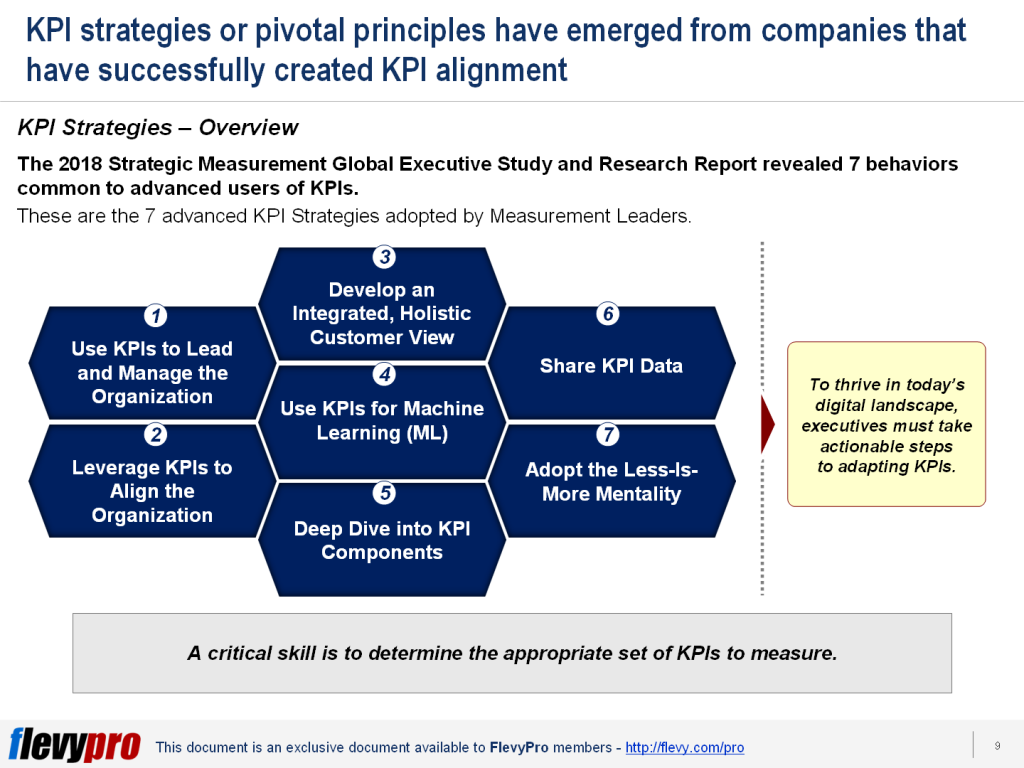Editor's Note: Take a look at our featured best practice, KPI Compilation: 800+ Corporate Strategy KPIs (186-slide PowerPoint presentation). This presentation is a comprehensive collection of Key Performance Indicators (KPI) related to Corporate Strategy. A KPI is a quantifiable measure used to evaluate the success of an organization, employee, or process in meeting objectives for performance.
KPIs are typically implemented at [read more]
Also, if you are interested in becoming an expert on Performance Management, take a look at Flevy's Performance Management Frameworks offering here. This is a curated collection of best practice frameworks based on the thought leadership of leading consulting firms, academics, and recognized subject matter experts. By learning and applying these concepts, you can you stay ahead of the curve. Full details here.
* * * *
“Selecting the right measure and measuring things right are both art and science. And KPIs influence management behavior as well as business culture.”
― Pearl Zhu, CIO Master: Unleash the Digital Potential of It
The 2018 Strategic Measurement Global Executive Study and Research Report showed that business leaders worldwide are struggling  to strike a workable balance between tactical and strategic KPIs; operational and financial KPIs; and KPIs that effectively capture the moment while anticipating the future. This imbalance is a source of measurable dissatisfaction and concern as data for KPI improvements continues to increase.
to strike a workable balance between tactical and strategic KPIs; operational and financial KPIs; and KPIs that effectively capture the moment while anticipating the future. This imbalance is a source of measurable dissatisfaction and concern as data for KPI improvements continues to increase.
In today’s accelerating technological innovation, intensifying competitive pressure, and increasing customer expectations, business leaders are forced to rethink how they use KPIs (Key Performance Indicators) to lead and manage the enterprise.
These trends – individually and collectively – have particular relevance to Chief Marketing Officers and other marketing executives. They are increasingly finding themselves accountable for growth-oriented objectives. Hence, there is a need to explore new and novel KPIs for assessing growth.
The Use of KPI Alignment Index
A KPI Alignment Index guides organizations in determining whether they have aligned the use of KPIs. This index is build based on the concept of KPI Alignment. It determines what leading organizations are doing and measures whether KPIs within an organization correctly relate to one another.
Most importantly, it illuminates and highlights how actions of organizations set them apart from the rest of the pack which is essential in Strategy Development. This determines its competitive edge. Technically, the KPI Alignment Index consist of 6 questions and answers are selected using a 5-point scale. Z-scores then are calculated for each of the 6 questions and their respective means.
KPI alignment is critical for organizations as it defines its successful strategy execution and lasting performance improvement. To thrive in today’s digital landscape, organizations must take actionable steps to adapt KPIs. Adapting KPIs successful require initiating Seven Key Performance Indicator (KPI) Strategies.
The Key Performance Indicator (KPI) Strategies
There are seven (7) Key Performance Indicator (KPI) Strategies; each contributing to the organization’s successful KPI alignment.

Organizations must have a good understanding of the seven (7) KPI Strategies as KPI definition, development, and deployment will lead organizations to command the lion’s share of leadership time and focus.
Let us take a look at three (3) Key Performance Indicator (KPI) Strategies.
- Use KPIs to Lead and Manage the Organization. This is the first KPI strategy that focused on the use of KPIs as a tool for Business Transformation. It ensures the use of KPIs to tactically manage a business and lead an organization into the future. Organizations that use KPIs as leadership tools look to leading indicators to frame their strategy. McDonald’s is one organization that has grown plan with seven (7) drivers; each drive has up to two (2) future-oriented leading indicators and one lagging indicator to measure success.
- Leverage KPIs to Align the Organization. KPIs to Align is a strategy that is focused on creating internal organizational alignment around shared KPIs. There is an alignment of internal, employee-related KPIs and financial or process KPIs with customer experiences that organizations seek to create.
- Develop an Integrated, Holistic Customer View. This is the third KPI strategy that is focused on a customer-centric KPI. This maximizes the use of externally focused KPIs that enable organizations to better segment and engage customers and have a Customer-centric Design. A good example of a company that maximizes the use of this strategy is Colgate-Palmolive. The organization emphasizes more on KPIs that show how customers are currently interacting with its brands in terms of changing consumer sentiments, future expectations, consumer trends, and others that can contribute to making their brand stronger.
To dive deeper into the 7 KPI Strategies, we have 2 framework presentations that span across all 7 KPI strategies:
It’s important to note executives must go beyond traditional KPI frameworks to truly leverage these metrics for strategic advantage. Rather than just balancing tactical and strategic KPIs, consider integrating consulting frameworks that allow for continuous realignment with evolving organizational goals.
This ensures KPIs are not static but dynamically adapt to market shifts and internal changes. Strategic management must embed KPI development deeply within the organization’s culture, transforming them from mere metrics into vital tools for sustained growth.
Focus on creating KPIs that serve not just as performance indicators but as foresight tools. Use KPIs to not only measure success but also predict future trends and challenges. This proactive approach requires embedding advanced analytics into your KPI strategy, turning data into actionable insights. During strategic planning sessions, present these insights in a clear, concise manner using PPT presentations, making them accessible and understandable for all stakeholders.
Enhance KPI alignment by fostering a holistic, customer-centric perspective. Align KPIs across all functions, ensuring that customer experiences drive internal metrics. This means developing KPIs that reflect real-time customer interactions, sentiments, and future expectations. By doing so, organizations can not only track performance but also drive strategic decisions that enhance customer satisfaction and loyalty. This approach positions KPIs as integral to strategic planning, guiding the organization towards sustained success.
Interested in gaining more understanding of Key Performance Indicator (KPI) Strategies? You can learn more and download an editable PowerPoint about Key Performance Indicator (KPI) Strategies here on the Flevy documents marketplace.
Are You a Management Consultant?
You can download this and hundreds of other consulting frameworks and consulting training guides from the FlevyPro library.

21-slide PowerPoint presentation
There are clear and measurable differences that exist between organizations that use Key Performance Indicators (KPIs) to monitor and assess performance and those that use KPIs to guide and drive performance improvements. Data-driven and customer-oriented leaders use KPIs to transform their
[read more]
Want to Achieve Excellence in Performance Management?
Gain the knowledge and develop the expertise to become an expert in Performance Management. Our frameworks are based on the thought leadership of leading consulting firms, academics, and recognized subject matter experts. Click here for full details.
Performance Management (also known as Strategic Performance Management, Performance Measurement, Business Performance Management, Enterprise Performance Management, or Corporate Performance Management) is a strategic management approach for monitoring how a business is performing. It describes the methodologies, metrics, processes, systems, and software that are used for monitoring and managing the business performance of an organization.
As Peter Drucker famously said, "If you can't measure it, you can't improve it."
Having a structured and robust Strategic Performance Management system (e.g. the Balanced Scorecard) is critical to the sustainable success of any organization; and affects all areas of our organization.
Learn about our Performance Management Best Practice Frameworks here.
Readers of This Article Are Interested in These Resources

141-slide PowerPoint presentation
This presentation is a comprehensive collection of over 600+ Key Performance Indicators (KPI) related to Sales Management and Strategy. Leverage these Sales KPIs to elevate the performance across your Sales Organization.
A KPI is a quantifiable measure used to evaluate the success of an
[read more]

141-slide PowerPoint presentation
This presentation is a comprehensive collection of Key Performance Indicators (KPI) related to Supply Chain Management (SCM). A KPI is a quantifiable measure used to evaluate the success of an organization, employee, or process in meeting objectives for performance.
KPIs are typically
[read more]

35-slide PowerPoint presentation
Elevate your team's performance and strategy execution to new heights with the Performance Scorecard Framework, crafted by former strategy consultants from elite firms such as BCG and EY. This unique tool combines the strengths of the Balanced Scorecard with an exclusive proprietary methodology. It
[read more]

1112-slide PowerPoint presentation
Curated by McKinsey-trained Executives
Unlocking Business Success: The Complete Digital Transformation Self-Assessment Toolkit
In today's fast-paced business environment, organizations are under increasing pressure to adapt and evolve. Digital transformation has become a crucial strategy for
[read more]
 to strike a workable balance between tactical and strategic KPIs; operational and financial KPIs; and KPIs that effectively capture the moment while anticipating the future. This imbalance is a source of measurable dissatisfaction and concern as data for KPI improvements continues to increase.
to strike a workable balance between tactical and strategic KPIs; operational and financial KPIs; and KPIs that effectively capture the moment while anticipating the future. This imbalance is a source of measurable dissatisfaction and concern as data for KPI improvements continues to increase.




